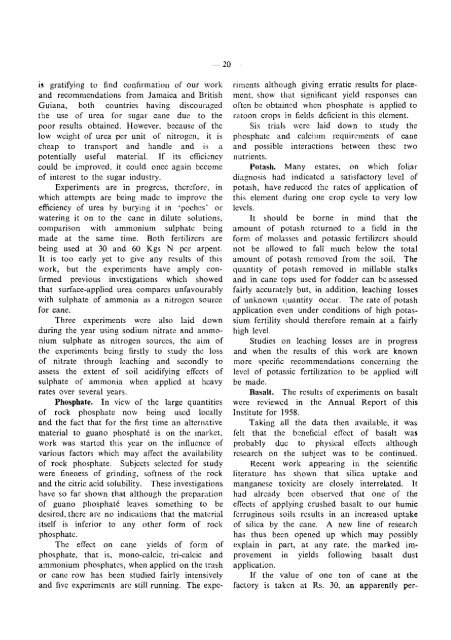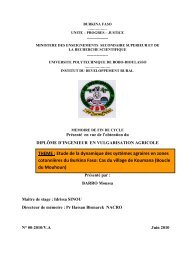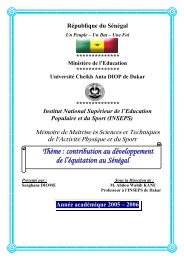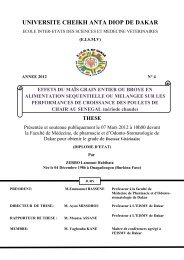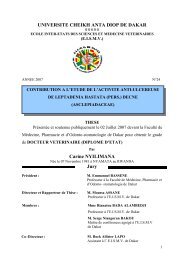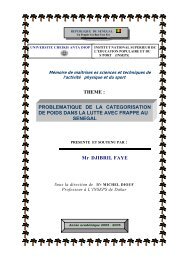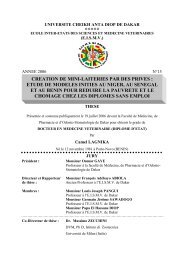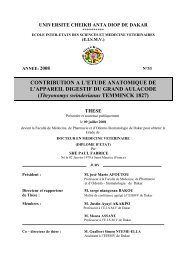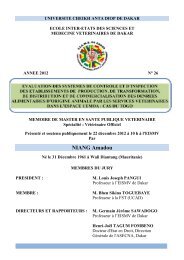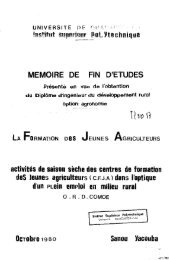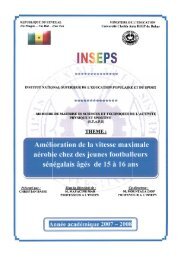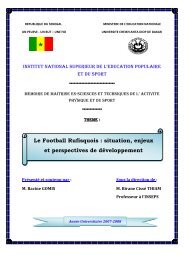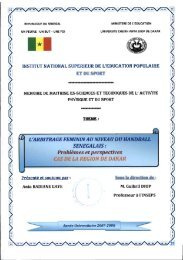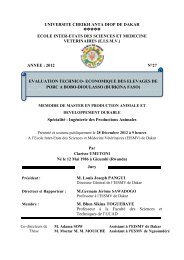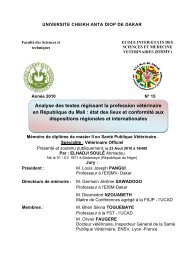-19-In order to obtain early information on thepossi ble drought resistance of new varieties, twoobservation plots have been started at MonTresor and St. Antoine and include at presentabout 20 varieties.The results of variety and pro-release trialsarc reviewed elsewhere. Reference should bemade however to several varieties, some ofwhich had been mentioned in earlier reports:M. 305/49. The results obtained in <strong>1961</strong>were not outstanding although this varietyperformed well in the humid area.M. 272/52 and M. 423/51. Both varietieshave produced better yields than Ebene 1/37 insuperhumid areas but were markedly inferiorto the standard variety, M. 147/44, in subhurnid,humid and irrigated localities. It appears alsothat M. 423/51 is susceptible to the stalk borer.M.409/51. This variety had shown promisein 1959. Its sucrose content is high, but it wiIIhave to be studied more closely in view of theinferior results obtained in two trials.M. 81/52. It is disappointing to recordthat this promising variety which performed wellso far, is susceptible to leaf scald. Its releasefor cultivation is therefore very doubtful.M. 13/53. Has given good results on irrigatedlands.M. 658/51. Promising for humid zone.R.397. This is the first Reunion variety tobe tested in Mauritius. It is thought from theresults of pro-release variety trials that it mayhave a useful place in subhumid areas. R.397flowers abundantly.N. Co, 310. This variety which is grown ona large scale in many sugar producing countriesis very disappointing under Mauritius conditionsand has performed particularly badlyin the superhumid zone.B. 41227, PR 1000. Both these varietieshave been included in trials under varying climaticconditions of the island but appear to beof no commercial interest.In order to diversify the genetical materialavailable for crossing and to extend furtherthe choice of commercial varieties, an intensiveprogramme of introductions from abroad wasdecided upon several years ago. The 48 canevarieties now undergoing quarantine will bereleased in March 1962, and it is hoped tostart another quarantine cycle a few monthslater.SOILS AND FERTILIZERSSoil Survey. The preliminary classificationof Mauritius soils was completed during theyear and the great soil groups mapped ona scale of I: 100,000. In this connection, thekind assistance received from the Department ofOverseas Survey, where the map is being printed,is gratefully acknowledged.The map shows the boundaries of the soilgroups, the 30 ~..~ slopes and the degree of rockinessand stoniness which, because of theirlocal importance, have been stressed by suitablemarkings.Twelve major mapping units are distinguished:low humic latosol, humic latosol,humic ferruginous latosol, latosolic reddishprairie, latosolic brown forest, dark magnesiumclays and grey hydromorphic clays, low humicgleys, mountain slope complexes, alluvial soils,lithosols and regosols, the only examples of thelatter in Mauritius being the calcareous sands.Work also progressed on the description ofsoil families within each great soil group.Mapping on the scale of I: 25,000 was alsostarted and fertility surveys were carried outby several estates whose chemists worked underthe supervision of the Chemist of the Instituteduring the intercrop period.The first results of mineralogical analyseshave been received from the RothamstedExperiment Station, England, and are presentedwith general comments in this report.Nitrogen. Conclusive evidence was presentedseveral years ago* that urea wasinferior to sulphate of ammonia as a nitrogensource for sugar cane when the fertilizerswere applied on the stool. As this is thenormal practice in Mauritius, it was recommendedthat planters should not use urea. It• Ann. Rep. M.S.I.R.l., 1959, 1960.
-20is gratifying to find confirmation of our workand recommendations from Jamaica and BritishGuiana, both countries having discouragedthe use of urea for sugar cane due to thepoor results obtained. However. because of thelow weight of urea per unit of nitrogen, it ischeap to transport and handle and i,; apotentially useful material. If its efficiencycould be improved. it could once again becomeof interest to the sugar industry.Experiments are in progress, therefore, inwhich attempts are being madc to improve theefficiency of urea by burying it in 'pochcs ' orwatering it on to the cane in dilute solutions,comparison with ammonium sulphate beingmade at the same time. Both fertilizers arebeing used at 30 and 60 Kgs N per arpent.It is too early yet to give any results of thiswork, but the experiments have amply confirmedprevious investigations which showedthat surface-applied urea compares unfavourablywith sulphate of ammonia as a nitrogen sourcefor cane.Three experiments were also laid downduring the year using sodium nitrate and ammoniumsulphate as nitrogen sources, the aim ofthe experiments being firstly to study the lossof nitrate through leaching and secondly toassess the extent of soil acidifying effects ofsulphate of ammonia when applied at heavyrates over several years.Phosphate. In view of the large quantitiesof rock phosphate now being used locallyand the fact that for the first time an alternativematerial to guano phosphate is on the market,work was started this year on the influence ofvarious factors which may affect the availabilityof rock phosphate. Subjects selected for studywere fineness of grinding, softness of the rockand the citric acid solubility. These investigationshave so far shown that although the preparationof guano phosphate leaves something to bedesired, there are no indications that the materialitself is inferior to any other form of rockphosphate.The effect on cane yields of form ofphosphate, that is, mono-calcic, tri-calcic andammonium phosphates, when applied on the trashor cane row has been studied fairly intensivelyand five experiments are still running. The experirnentsalthough giving erratic results for placement.show that significant yield responses canoften be obtained when phosphate is applied toratoon crops in fields deficient in this clement.Six trials were laid down to study thephosphate and calcium requirements of caneand possible interactions between these twonutrients.Potash. Many estates. on which foliardiagnosis had indicated a satisfactory level ofpotash, have reduced the rates of application ofthis element during one crop cycle to very lowlevels.It should be borne m mind that theamount of potash returned to a field in theform of molasses and potassic fertilizers shouldnot be allowed to fall much below the totalamount of potash removed from the soil. Thequantity of potash removed in millable stalksand in cane tops used for fodder can be assessedfairly accurately but. in addition, leaching lossesof unknown quantity occur. The rate of potashapplication even under conditions of high potassiumfertility should therefore remain at a fairlyhigh level.Studies on leaching losses are in progressand when the results of this work are knownmore specific recommendations concerning thelevel of potassic fertilization to be applied willbe made.Basalt. The results of experiments on basaltwere reviewed in the <strong>Annual</strong> <strong>Report</strong> of thisInstitute for 1958.Taking all the data then available, it wasfelt that the beneficial effect of basalt wasprobably due to physical effects althoughresearch on the subject was to be continued.Recent work appearing in the scientificliterature has shown that silica uptake andmanganese toxicity are closely interrelated. Ithad already been observed that one of theeffects of applying crushed basalt to our humicferruginous soils results in an increased uptakeof silica by the cane. A new line of researchhas thus been opened up which may possiblyexplain in part, at any rate, the marked improvementm yields following basalt dustapplication.If the value of one ton of cane at thefactory is taken at Rs. 30. an apparently per-
- Page 2 and 3: MAURITIUS SUGAR INDUSTRYRESEARCHINS
- Page 4 and 5: SUGAR MANUFACTUREI. The performance
- Page 6 and 7: STAFFLISTDirectorAgronomistBotanist
- Page 8 and 9: SPECIALSTUDIES FUNDThe Special Stud
- Page 10 and 11: INTRODUCTIONTH E act i v it i e s o
- Page 12 and 13: -11-Zlb"e, ~~J2<
- Page 14 and 15: -13-M.134/32M.147/44M.31/45M.202/46
- Page 16: -15-varieties cultivated in Mauriti
- Page 19: .. 18··the indications are that i
- Page 23 and 24: -~ 22--CANEDISEASESThe main patholo
- Page 25 and 26: .- 24·-occupying intermediate posi
- Page 27 and 28: -25-Average 1958-1961 (1960 exclude
- Page 29 and 30: -27-The first results obtained from
- Page 31 and 32: -29-have confirmed those obtained l
- Page 33 and 34: -31-on vanous aspects of sugar manu
- Page 35 and 36: -33-Some of the more important rece
- Page 37 and 38: Fig 12. Top . Some of the se lf-sow
- Page 39 and 40: -36 ---Table 2.Year1956195719581959
- Page 41 and 42: -38-(ii)Transplantation of seedling
- Page 43 and 44: -40--The efficiency of selection pr
- Page 45 and 46: -42--Table 8.Distribution of trials
- Page 47 and 48: -44-M.253/48 - This variety, derive
- Page 49 and 50: -46 --The results for the aluminium
- Page 51 and 52: -48-from moisture stress and leaves
- Page 53 and 54: - 50A linear relationship was found
- Page 55 and 56: F ig. 19 Dwarf or multiple bud dise
- Page 57 and 58: -52-Table 14.Summary of results obt
- Page 59 and 60: -54-Table 17. Nurseries established
- Page 61 and 62: Fig . 2] .Perfect stage of the red
- Page 63 and 64: -56-Several methods have been used.
- Page 65 and 66: -58-duties have been defined. The m
- Page 67 and 68: -60-664 flies, all in good state an
- Page 69 and 70: -61-(b)BiologyProgress was made wit
- Page 71 and 72:
WEEDCONTROLE. ROCHECOUSTE1. HERBICI
- Page 73 and 74:
-65-Table 20.Comparative efficacy o
- Page 75 and 76:
CULTIVATION, IRRIGATION, CLIMATE1.
- Page 77 and 78:
-69-cos cells at a depth of 6" indi
- Page 79 and 80:
-71-It will be observed from the ab
- Page 81 and 82:
:rwo.: 40~~a: . J S~X>""-c L JO2 52
- Page 83 and 84:
-75-Table 28. Sucrose per cent cane
- Page 85 and 86:
-- 77--Table 32. Syrup, massecuites
- Page 87 and 88:
-79-A summary of the solids balance
- Page 89 and 90:
-81-Non-sugars like silica, starch,
- Page 91 and 92:
-83-Table 37.Comparison between Fil
- Page 93 and 94:
Fig . 27. Isolates on osrnophilic a
- Page 95 and 96:
-85--DOUWES OEKKER (1960) -- Report
- Page 97 and 98:
-87-one calculated from the pol rea
- Page 99 and 100:
-89~(b). THE DETER!\II\TATlO\T OF R
- Page 101 and 102:
-91-The Brix of the cake is obtaine
- Page 103 and 104:
-93-(SAINT ANTOINE, 1959) the 1st e
- Page 105 and 106:
o..8584,.80"j::I BR E~i~c xn s-95 -
- Page 107 and 108:
BY-PRODUCTS1. THE COMPOSITION OF SC
- Page 109 and 110:
-99-impossible to obtain a reliable
- Page 111 and 112:
-101--Fibre and insoluble carbohydr
- Page 113 and 114:
-105-of research that could lead to
- Page 115 and 116:
-104-REFERENCESABRAMS, J. T. (1961)
- Page 117 and 118:
-107-MoistureProtein (N x 6.25)Fat
- Page 119:
-109-ACKNOWLEDGMENTSExtraction of t


